Happy Eid!
We at the embassy receive 20 holidays a year, the maximum allowed by State. Were there no maximum, I'm sure we'd have over 25, what with the combined Christian, Hindu, and Muslim holidays. Well, today is Eid ul-Adha, the second Eid of the year. The first Eid marks the ending of Ramadan. This second Eid, as Wikipedia explains it, is celebrated by Muslims worldwide as a commemoration of Prophet Ibrahim's willingness to sacrifice his son for God.
I believe that son is Isaac and that God at the very last minute stayed Ibrahim, thanked him for his steadfastness (and willigness to sacrifice his son), and then provided a goat or two to finish the sacrifice. Without going into the question of what kind of God would test a person to that degree, it is quite an illustration of putting your trust in God.
But who ever asks in Sunday School, "But what happened to the goat?" Well, the goat got no reprieve, and apparently that's carried on for generations. Again turning to Wikipedia for guidance:
The first day is the primary holiday, on which men, women, and children are expected to dress in their finest clothing and perform prayer (Salah) in a large congregation. Muslims who can afford to do so sacrifice domestic animals, usually sheep, as a symbol of Ibrahim's sacrifice; this sacrifice is called "Qurbani." The meat is distributed amongst their neighbors, relatives, and the poor and hungry.
So at least the meat goes for a good cause.
Anyway, as today was a holiday, I ventured out to Old Delhi, which is the main area in Delhi in which Islam is the dominant religion and where Urdu is spoken and written. I love the streets of Old Delhi, which are packed with people, full of life, and which often end up as mini-labyrinths. I made many friends whenever I took a picture, and I cemented the friendship by saying "Eid mubarak ho!" They responded in kind, and we would chat in Hindi/Urdu for a minute. It's a simple ritual, but really very pleasant. Here are a few of the pictures I took:
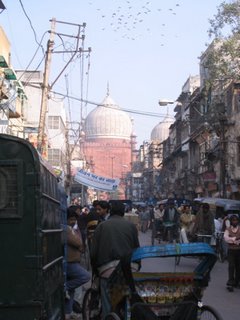
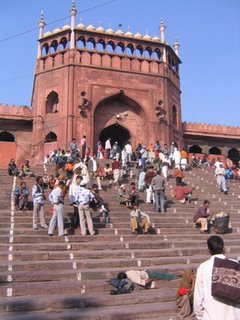
Here I'm approaching the Jama Masjid (or "Friday Mosque"). Check out the traffic. The cars were dominant at first, but gave way quickly to the bicycle rickshaw and scooters. In the alleyways, it ended up being dominated by pedestrians, camels, and goats. Finally, I got to the mosque itself. People were milling around, and many were in their finest clothing, mostly long white kurtas and pants for the men. (Some were playing cricket in their finest clothing, in a field to the side of the mosque, but hey, it's a holiday, right?)
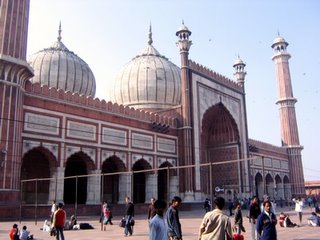 The Jama Masjid is impressive, as are most of the mosques and monuments made by the Mughals. Most of the work done in that era seems to me to be a great combination of masculine and feminine architecture, what with the solid, almost menacing bulk combined with the intricate engraving and ornamentation. I can't wait to see the Taj Mahal...
The Jama Masjid is impressive, as are most of the mosques and monuments made by the Mughals. Most of the work done in that era seems to me to be a great combination of masculine and feminine architecture, what with the solid, almost menacing bulk combined with the intricate engraving and ornamentation. I can't wait to see the Taj Mahal...I did have one funny, then sad moment. At first I thought it was great the way many of the goats had festive necklaces on. I didn't realize that this was their last moment of celebration before reprising their ancestor's "No, no Isaac, allow me" moment. As a result, there were large hunks of fresh goat meat all around, as well as bloody pelts. Don't scroll down if you don't want to see the next two pictures...
Happy Goats
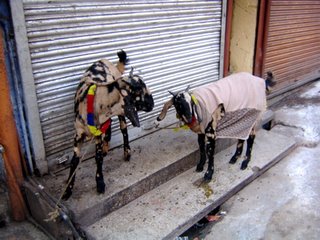
...
Mission Accomplished! (Sorry goats...)

Just so I don't end on that gory note, I'll share one more thing I like about Delhi, namely the multi-lingual signs. Throughout much of Delhi, you'll find signs in three or even four languages. In Old Delhi, it's Urdu, Hindi, and English. In New Delhi, it's Hindi, English, Punjabi, and Urdu. This is a sign for the Hotel Deluxe in Old Delhi, and a bad picture of the road sign by the Embassy. I'll try to get a better picture of Punjabi, because it looks like it's written by martians...

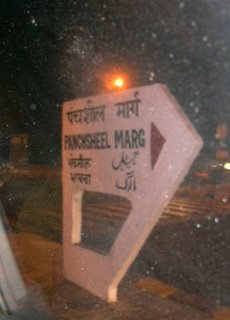
Happy Eid!

5 Comments:
Happy goats! ... ohh ...
Well, at least they got necklaces.
I've heard somewhere that in Muslim traditions, all that sacrifice stuff happens to Ishmael, and the story sort of follows him from that point on instead of Isaac.
What does "Panchsheel" mean? US Embassy?
We know Ibrahim as Abraham, of course, and I never heard about the Ishmael legacy. I know there is one somewhere. Anyway, awesome pics, including the deadish animals...did you get any of the meat? Yum!
1. I would love to hear more about that possible swap between Isaac and Ishmael. That would be amazing if it were true.
2. No meat for me. But you know, certainly more honest to see it that way on the street. The blood's a little off-putting, but...
3. Panscheel. From some other website: "The relationship between China and India over Tibet is a long and complicated one. That relationship is often referred to in the diplomatic code word Panscheel, the doctrine under which Nehru originally tried to establish peaceful relations with China. Thus the Chinese representative referred to the principles of "peaceful coexistence" as the working basis for Indian "restraint" in these areas."
4. Punjabi script. Check out this website for some great examples on different scripts in South Asia. All the examples are spelling the words to their right. The Devanagari-based ones are all fairly similar, but just out of reach. The Arabic scripts are totally different, and the Dravidian ones - whoo - are from another planet.
From the Wikipedia entry on Ishmael: "Islam asserts that he was the one nearly sacrificed, not Isaac, (or Ishaq in the Qur'an)." However, he was still the first born, from the second wife (no mention of Hagar being Sarah's maidservant). Instead of being forced into the desert to live an unhappy life, she and Ishmael went there on the orders of God. Fascinating!
Vedddy interesting I did not know that. I wonder which version of Ishmael's story is involved in "call me Ishmael".
Post a Comment
<< Home